So here comes my guide to Siem Reap – beyond Angkor Wat. A place that at first made me feel bad. And ignorant.
Because contrary to expectations, Angkor did not blow me away.

This lack of enchantment makes me feel like such a jaded snob who thinks to have seen it all. However, I remember how the temple site in Sukhothai dazzled me. Was the spell broken? Will I no temple ever mesmerize me again?
Wonders of the World
“You should go to Machu Picchu.”
I turn around and there is a very handsome guy, blasé Latino type.
“I’ve been to Machu Picchu”, I inform him, “and it did impress me a lot. Actually so much that I cried.
But I think it’s because of the height.
You can see the whole complex at once on these mist-covered mountains – you feel so close to heaven.
Where are you from, anyway?”
“From Perú.”
Okay, that explains it all.

Although, some require a bit of climbing.
Reason #1
But yes, here we have reason #1 why Angkor didn’t take me by storm and brought me to tears.
It’s a really, really vast area with lots of jungle-ish parts. Also, there are rice paddies, rows of hawker shops, and restaurants between the temples’ remnants.

Those structures are, undoubtedly, all very nice and impressive, each and every one in its own way. However, there is not the overwhelming effect of seeing it at once in all its glory.

Reason #2
Reason #2 are the masses of people. Especially the short circuit that includes the famous Angkor Wat is packed with people.
People equals hordes. Especially Chinese performing stampedes, pushing people aside and occupying merciless the most beautiful spots with never-ending shootings of the most ridiculous poses.
I mean, you are basically climbing very dusty rocks in hellish heat.
Nevertheless, these visitors are wearing cute summer dresses with strappy sandals, using this rich heritage simply to stage themselves, spurred on by the directing yells of their photographing husbands.
And since they are always in big, very noisy crowds, they are impossible to ignore.
That, my friends, has a very disenchanting impact.
Angkor Thom
Be that as it may, nobody goes to Cambodia without paying Angkor a visit.
And it is undoubtedly one of the most important archaeological sites in South-East Asia.
Reason #3
Everybody says so and everybody goes there. I was basically expecting to faint. And this, in conclusion, is the third, however, most important reason why Angkor didn’t overwhelm me. This truly fantastic site didn’t have the chance to meet my high expectations. After all, they had been triggered for years.
On a partly forested area of about 400 square kilometers, there is an archeological park of remnants from the different epochs of the Khmer Empire. This dates from the 9th to the 15th century.
The Short Circuit
The small circuit starts at Angkor Wat and runs about 17 kilometers.

It is flanked by Gods (to the left) and demons (to the right), both holding a serpent.
I did it including the sunrise. Wise decision – not only because of the sunrise, but because there are fewer people around in the early morning. The large groups of mainly Chinese tourists arrive a bit later – and then it becomes unbearable.
I arrived on the site at approximately 5:30 a. m. to see the sunrise over Angkor Wat.
Great idea.
A great idea that I shared with a couple of hundred other early birds arriving from all directions mostly in tuk-tuks, but also in cars, vans, motorcycles, and even bicycles.
Walking towards Angkor Wat, these hundreds of people crossed in the pitch dark a plastic bridge that felt like a bouncy castle.
Good Morning, Cambodia
And then we were standing there staring towards the temple while the eager hawkers were noisily advertising all sorts of goods including the only sensible one: hot coffee.
Standing there staring for a while, it became evident that this day, there would be no proper sunrise. Of course, the sun did arise, it was not the end of the world after all. But it did its job bashfully hidden behind clouds.

As soon as I realized that, I left the crowd and went into the temple.
Let me tell you, at 5:45 a. m. you find yourself even at Angkor Wat with about two handfuls of other pessimists who gave up the idea of a sunrise.
Hence, it’s perfect timing. No groups, no crowds.
The central tower which can be more or less comfortably climbed over wooden stairs opens at 6:40 a. m.
I was in line at 6:25 – about twenty people before me, perfect timing.
Later, I talked to a guy who had to wait for three hours since they let in a hundred people at a time – max.
Angkor Wat
Angkor Wat is a massive three-tiered pyramid. There are five towers rising 65 meters from ground level. It’s Cambodia’s most iconic structure and its silhouette adorns the Cambodian flag.

A moat and a wall are surrounding this majestic structure.
King Suryavarman II (approx. 1095 – 1150) commissioned Angkor Wat in the early 12th century as a Hindu temple on a terrain of about 1 square kilometer.

Bayon
This temple got extremely popular because of its beautiful giant stone faces, a sign of classic Khmer art and architecture. It consists of 37 towers, many of which are adorned by four carved faces, looking toward the cardinal points. King Jayavarman VI. commissioned Bayon in the late 12th century as a Buddhist temple.

Because of the outstanding carvings, Wat Bayon served as a picturesque backdrop of many TV shows and movies, obviously, including Tomb Raider.
Baphuon
Baphuon is a large temple mountain in Angkor Thom. After extensive restorations, it is now accessible.
King Udayadityavarman II commissioned Baphuon in the 11th century as a Hindu temple.

Phimeanakas
Phimeanakas is a tall temple amidst Angkor Thom – at this moment not accessible. King Jayavarman V. (958 – 1001) commissioned Phimeanakas in the late 10th to early 11th century as a Hindu.

Terrace of the Elephants
Terrace of the Elephants is a terrace 2.5 meters high and 300 meters long.
Carved elephants and garudas, humanoid birds common in both Hinduism and Buddhism, are adorning the entire wall.



Terrace of the Leper King
A discolored and moss-covered statue, looking like a person with leprosy, gave the Terrace of the Leper King its name.
And King Yasovarman I. actually did suffer from leprosy.

King Jayavarman VII (1125 – 1218) commissioned both terraces in the late 12th century.

Ta Prohm
Ta Prohm is overgrown by huge fig and silk-cotton trees and only partially cleared. Therefore, it has something very enchanted, almost bewitched to it.
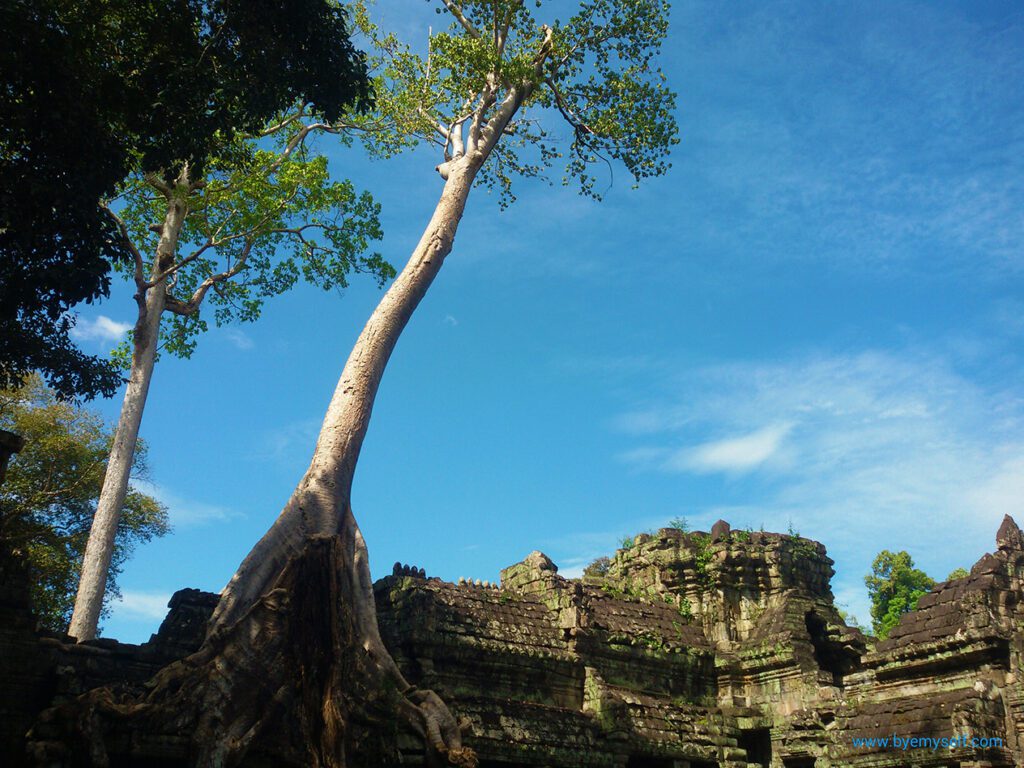
King Jayavarman VII (1125 – 1218) commissioned Ta Prohm between mid of 12th to early 13th centuries as a Buddhist temple.

Note: There is a fifth temple on the short circuit. Since I was quite tired from my morning shift that started at 5.30 a. m. at Angkor Wat, I saved that one for the next day.

The Large Circuit
The long circuit runs about 26 km / 16 miles and includes the less famous and popular temples – which are in no way less spectacular and often much more atmospheric and dreamy since the big tourist groups don’t get there.
Preah Kahn
Preah Kahn was initially a Buddhist monastery and school, catering to more than 1000 monks. Eventually, it was also King Jayavarman’s VII residence – during the reconstruction of his permanent home in Angkor Thom.
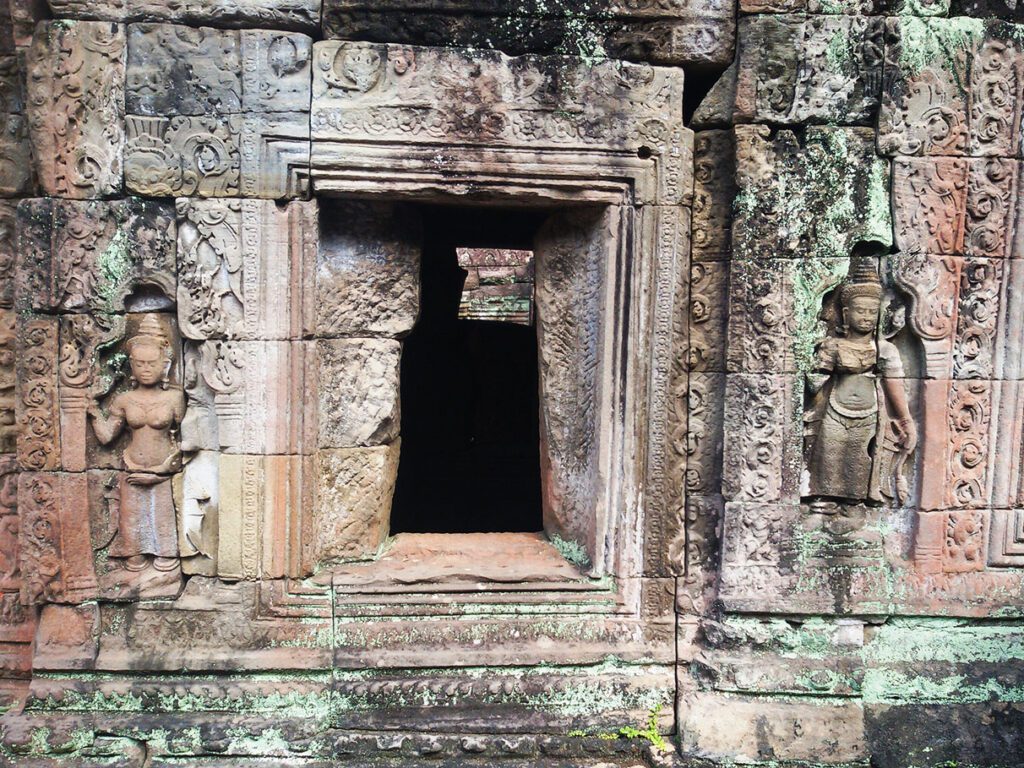

King Jayavarman VII (1125 – 1218) commissioned Preah Kahn in the late 12th century as a Buddhist monastery.

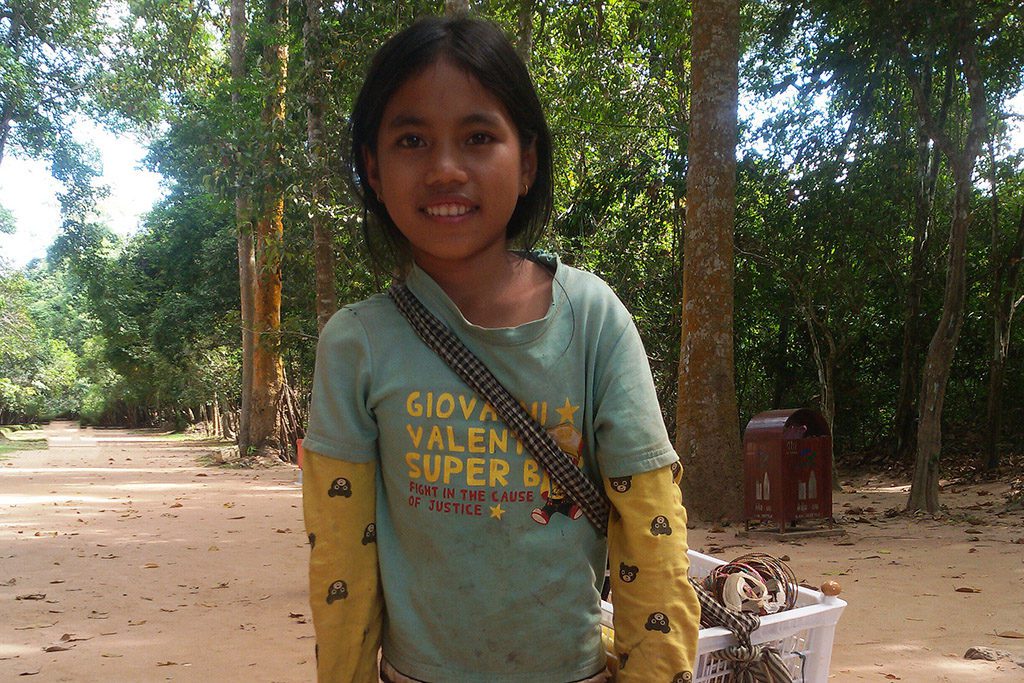
At Preah Kahn, I bought a pendulum mobile from
a lady the little girl to the left was with – therefore I took the liberty to ask her for a picture. I always ask before I take a picture – I find it common courtesy and hate it seeing strangers just snapping away).
I bought souvenirs from her mother and not from her or from any other kid. I believe that they shouldn’t be trained to sell or beg.
Nonetheless, here is a little tip: Things get cheaper the further you go on the circuits, i. e. at the first temples along the route the base price is much higher and it’s harder to haggle. At the last temples, they practically throw the stuff at you. Anyway, if you really love a particular piece e. g. for its design, it can happen that the following vendors do not have the same.
Helas, avoiding being duped in Cambodia is an almost impossible task.
Neak Pean
Neak Pean was originally dedicated to Buddha, however, it’s decorated with some Hindu images, too. The temple served probably an absolution purpose whereby the waters were believed to have healing powers. The central temple is located on the axis of a cross of eight pools. NeakPen was built in the late 12th century as a Buddhist temple by King Jayavarman VII (1125 – 1218)
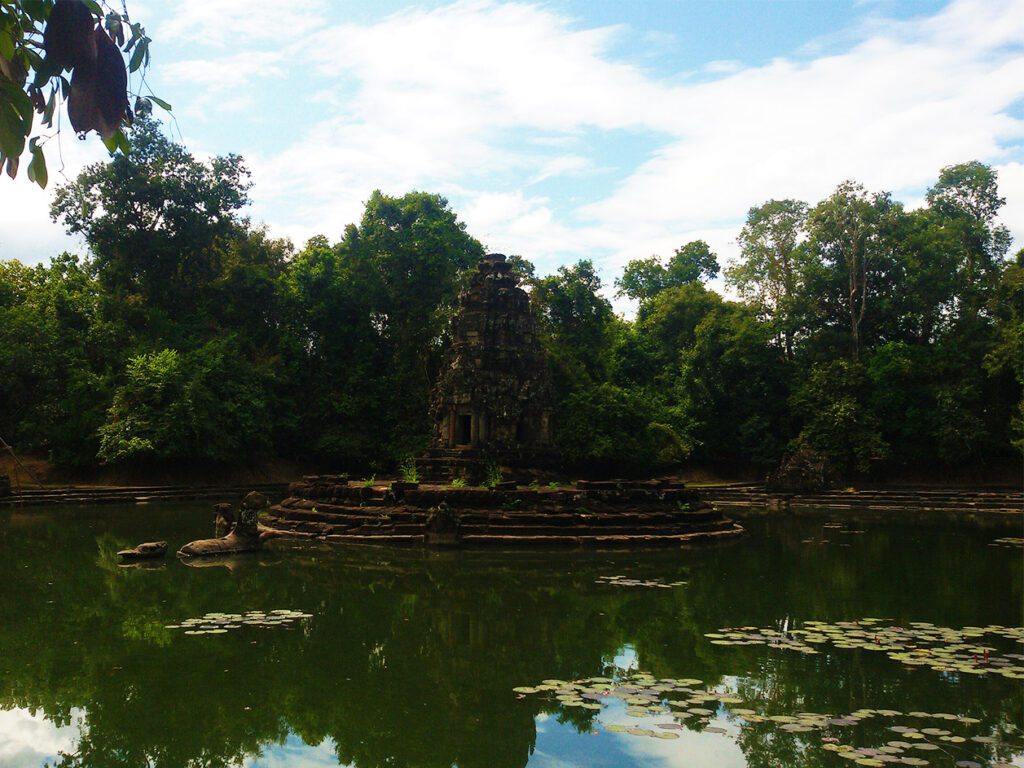
Ta Som
Ta Som, the most distant temple on the Large Circuit, is a small monastic complex. With its face tower and the cruciform interior, it deems like a miniature of Ta Prohm.

It was built in the late 12th century as a Buddhist temple by King Jayavarman VII (1125 – 1218)
Eastern Mebon
The Eastern Mebon is a large fragment of a temple mountain. It consists of three levels crowned by five towers. The temple is dedicated to Shiva in honor of the King’s parents.

The Eastern Mebon was built in the late 10th century as a Hindu temple by King Rajendravarman II (reign 944 – 968)

Banteay Kdei
Banteay Kdei was initially constructed as a Buddhist monastery over the site of an older temple. It is pretty much the same style as Ta Prohm.

It is in remarkably poor condition so some parts are not accessible. This is due to an inferior grade of sandstone and poor construction techniques.

Banteay Kdei was built in the late 12th and early 13th century as a Buddhist monastery by King Jayavarman VI (reign 1080 – 1107)

Srah Srang
Naga balustrades and guardian lions are adorning Srah Srang. The very remnants of a temple can be seen rather during the dry season when the water is low.
Srah Srang was built mid of the 10th and then again in the late 12th century. In the late 12th century, King Jayavarman VII (1125 – 1218) commissioned it as a Buddhist temple.

(Photo: Diego Delso, Srah Srang, Angkor, Camboya, 2013-08-16, DD 08, cropped 3:2, CC BY-SA 3.0)
Map
Angkor Thom
Beyond Angkor Wat
Roluos Group
Interestingly, the Roluos group were the first temples built to last and are made of brick with some carved plaster reliefs. The group consists of three temples: Preah Ko, Bakong, and Lolei. Many of the later temples in the Angkor group are based on these earlier temples.
The Roluos group is included in the Angkor ticket. Take this into consideration when buying your pass.
Preah Ko
Preah Ko consists of six beautifully carved towers on a platform. It was one of the first major temples of the empire at the early Khmer capital of Hariharalaya. Preah Ko was built in the late 9th century as a Hindu temple by King Indravarman I (reigned approx. 877 – 890)

Bakong
Bakong is a very impressive, 15 m / 49 ft tall temple. Its outer wall measures 650 x 850 m / 2132.5 x 2788.7 ft. Constructed by King Indravarman I (reigned approx. 877 – 890), Bakong is the first temple built in the temple mountain shape which influenced the temple architecture for the then following 400 years. It was built in the late 9th century as a Hindu temple.

There is a third temple part of the Roluos group, the tower temple of Lolei which was under renovation and completely covered by scaffolding, hence I didn’t take a picture.
Kampong Phluk
A trip to Kampong Phluk, one of the floating villages on the beautiful Tonle Sap Lake, can be easily combined with a trip to the Ruolus temples. You are gliding through a flooded forest after having taken a good look at the stilted houses of the village itself.
You pass a scenic panorama of floating markets, fish farms, and rice paddies.
The village is home to approximately 3000 fishermen and their families, mostly Khmer.
If the water levels at the flooded forest of Kompong Phluk are too low to be rowed by one of the ladies, you can as well walk along a treetop canopy walkway.
At the end of the tour, the boatman takes you to the Tonle Sap Lake, which actually looks like an ocean.
Not only the tour through the floating village is a truly Cambodian experience, but also along the way, it’s worth keeping the eyes open and looking around in order not to miss all the picturesque sceneries of rural Cambodian life.
Anyway, the trip to the village was really nice, I’ve never seen anything like this before. Also, I appreciated that the visitors are really getting to see the village and the real village life. It’s not some made-up Disney World-ish nonsense like I’ve seen e. g. in Tunisia where they take you to fake villages in the desert and you see exactly that the whole thing is a charade for the tourists and not genuine at all.
So I really liked floating through this legitimate area of Cambodian culture.
Overpaying Once More
Mr. Syna took me to the gateway for the floating village rides where I almost got a fit when the teller demanded 40 bucks for the boat ride.

Unfortunately, we were driving quite a long way so I couldn’t tell Mr. Syna that I had changed my mind. And I actually, didn’t change my mind, I just didn’t expect to pay 40 bucks for a boat ride.

I asked some ladies from Taiwan whom I had met at the Roluos temples how much they paid: 20 $. Back to the teller, complaining that others had to pay only 20.
Yes, but you are by yourself.
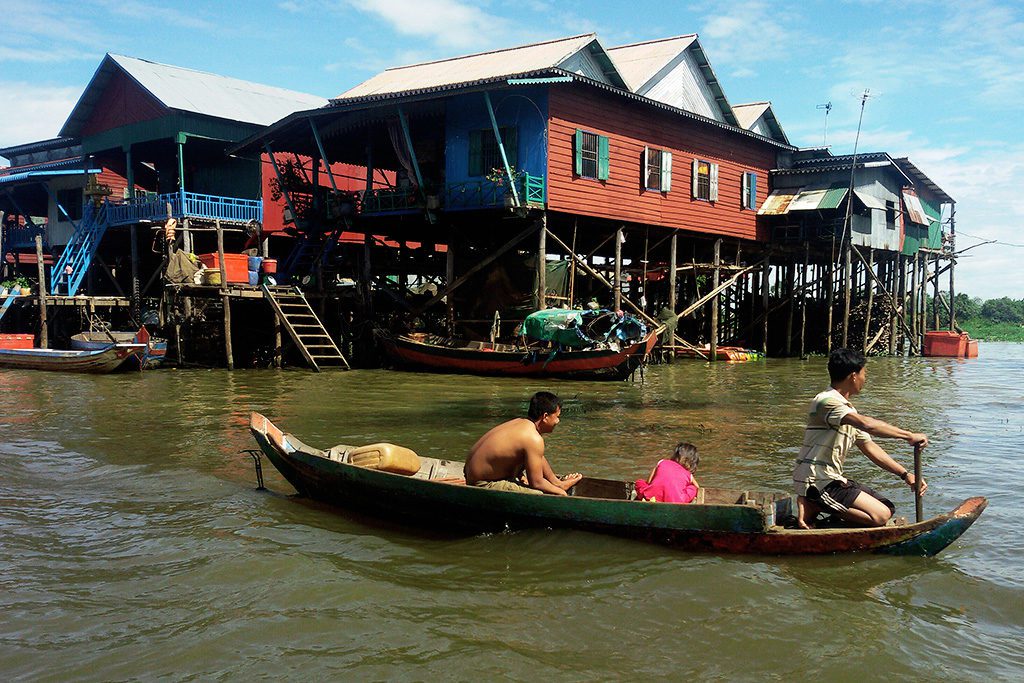
Although he got that right, I don’t understand why they hire a boat per party – which in my case was one, indeed – instead of putting people together on boats and charging let’s say 15 or even 20 bucks per person.
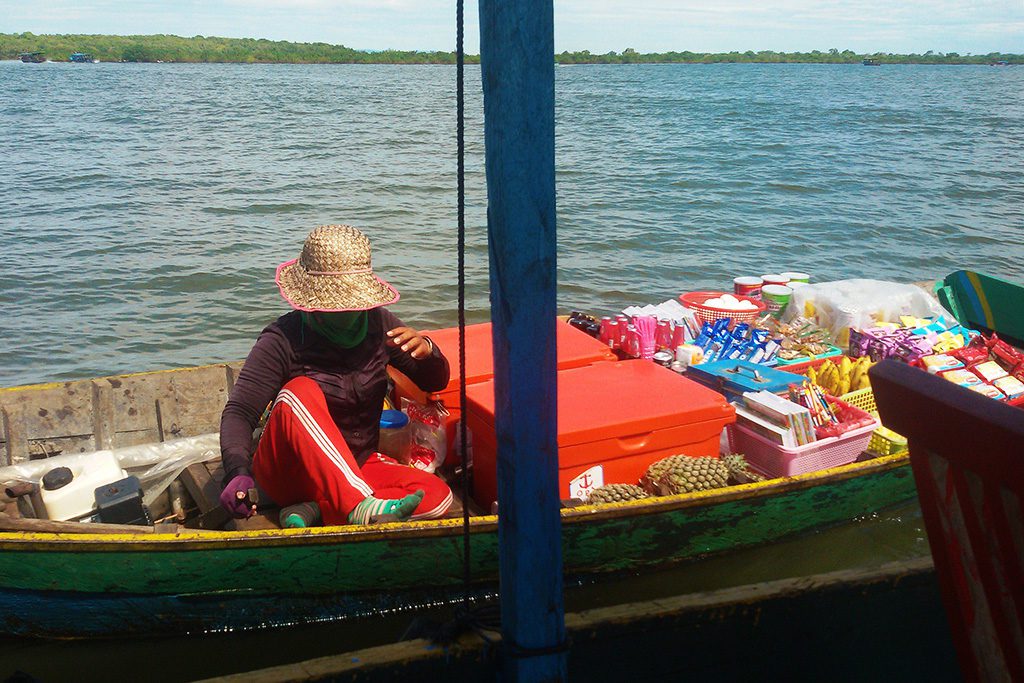
Sadly, it doesn’t matter if I understand it or not. It’s their business and they can run it as they please. If I don’t like it, I don’t get to see the floating village.
It wasn’t the teller who told me that, it was my sense. Albeit, I’m sure the teller would have told me exactly that – only his English is not good enough.
Visiting the Floating Village By Land
Later I learned from an Italian couple who denied to fork over 40 bucks that there is a possibility to visit at least parts of the village by tuk-tuk. They paid their driver 10 bucks extra for that.

And I actually remember having seen a dust road behind the houses built on steles.
Still, I find it more adequate to visit a village on water from the water.
Last But Not Least: Siem Reap
I was surprised at how much I actually liked Siem Reap. Obviously, tourism-wise, it’s indisputably Cambodia’s hottest hot spot. But still, it has areas that remain more or less ignored by large tourist crowds.
Although there are public buses and, of course, tuk-tuks, the most convenient way to explore Siem Reap is by cycling. Consequently, almost every guest house offers bike rental. Also, there are many independent bike rental businesses around.
Take Me To the River
There’s a river – that’s always an asset. And there are a couple of beautiful Wats even within the city limits.
Also, you can stock up on all kinds of handmade souvenirs at a big market with mainly tourists shop so you have to haggle a lot and be careful with scams and rip-offs.
Actually, I don’t even want to think about all the amounts that I have overpaid – starting with the silk scarves in Koh Dach. I think that I’ve paid six times as much as they cost elsewhere!
Again: I only hope that all the money that I was overpaying went to some really needy families with old parents and young kids.
Especially the south bank of Siem Reap river is quite pleasant and can be walked or cycled in the shade of many big trees.
There are various guest houses and almost all of them have a restaurant so that you can take a break as soon as you need one.

What’s funny in Cambodia is how provincial even bigger cities deem – even Phnom Penh has something countrified to it – by no means comparable to Bangkok, Ho Chi Minh City, or Hanoi.

And Siem Reap, although home to 175,000 inhabitants and therefore Cambodia’s fourth-largest city, even has lots of dusty roads as soon as you leave the mere center.
Going South
Coming from the airport west of the city center, national route #6 practically cuts Siem Reap in two halves. On this arterial road, you can do all your banking and practical shopping since there are various banks and large supermarkets and stores.

However, you should also pay Wat Kesararam and Preah Ang Chek as well as Preah Ang Chorm on the northern side of the road a visit.

Across the road from Preah Ang Chek is the official Royal residence. It can be admired, but not visited, since this is actually the King’s permanent home.
By the way: Especially if you are cycling, you should be super cautious and careful with the crazy traffic.
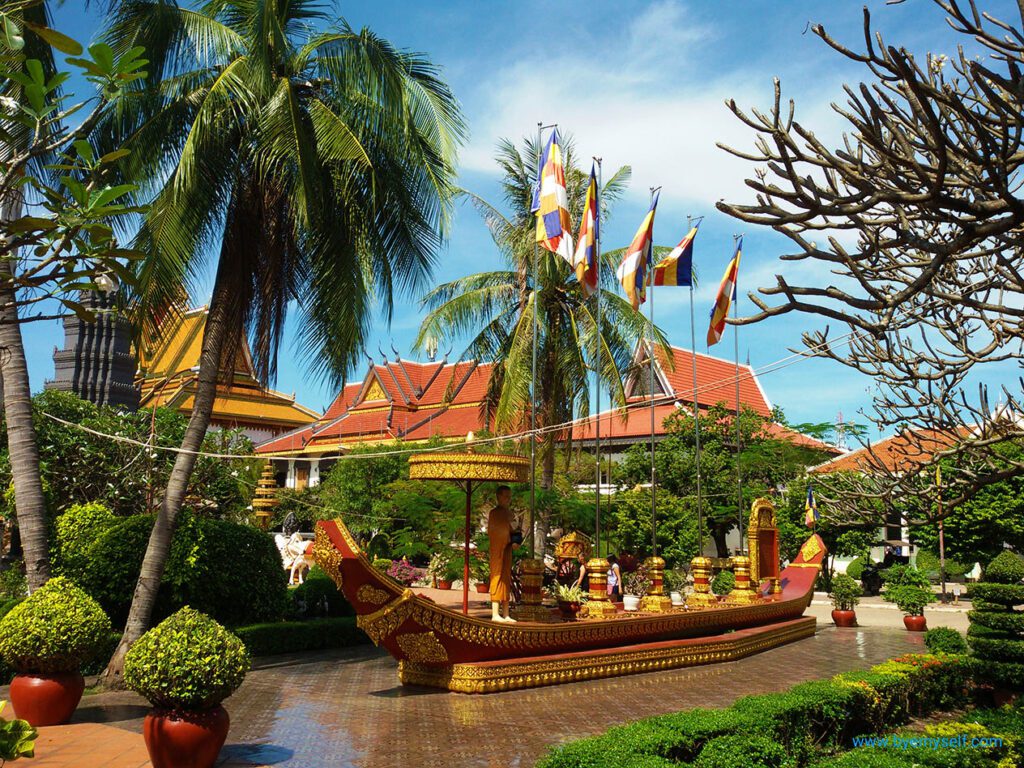
As you turn right into Pokambor Ave, you’ll get to the tourist area with the beautiful Wat Prom Rath.

You can take a little time out from the hustle and bustle of the city, go for a walk and admire the statues and structures.
There is also a laying and a seated Buddha.
Just three blocks down is the Old Market which actually caters to tourists. All sorts of souvenirs of more or less good quality are sold here. Be prepared to haggle a lot – and possibly still end up paying too much.
Not only the market, but also all the little shops and restaurants, and bars – including the infamous Pub Street – are designed for tourists.
Going North
I’d recommend crossing the Siem Reap river over the Old Market Bridge for going up north. You’ll see that cycling on Achar Sva Street is also more pleasant and less dangerous.

Going North, you can visit three Wats: Preah Polanka, Preah An Kau Saa, and Enkosey – all three of them with adjacent monasteries and schools.


Once you’re all the way out here and in case you don’t have a ticket to Angkor, go on and turn right into street 60. At the next big junction, called the Apsara Circle, you’ll see the huge ticket center on your left-hand side.
Note: Find the different ticket options and some practical info in the Angkor section below.
Coming back from the ticket center, cross the bridge on street 60 and turn either left to go back along the river or go on one block and turn left into Charles De Gaulle road.
Here you find a couple of the big, expensive hotels catering mainly to large groups of Chinese and Korean tourists and some stores selling souvenirs of higher quality, but also at exorbitant prices.
At number 968 is the Angkor National Museum where you can get further information on the ancient Khmer culture.
Angkor National Museum
No. 968, Vithei Charles de Gaulle
Siem Reap
Phone: + 855 – 63 – 966 601
Email: info@the-anm.com
So that’s about it for downtown Siem Reap.
It could be an agreeable little town, but it often isn’t because of uncontrolled mass tourism.
Map
Siem Reap
Practical Information
How to get there
Since Angkor is Cambodia’s main tourist site and sort of the country’s money machine, Siem Reap is one of three Cambodian cities that are accessible by national and international flights. It lies only 8 km from the city and is quickly and easily reachable by tuk-tuk.
Just like Phnom Penh International Airport, they have an excellent website where you get all the information to make your travel smooth.

There are, of course, many long-distance buses from places in Cambodia, but also from Thailand, going to Siem Reap. In Cambodia, especially the company Giant Ibis is recommendable:
Honestly, I was very nervous before the trip by night bus from Sihanoukville to Siem Reap.
There are so many accidents reported – especially on night buses. Also, after my adventures on boats and ferries, I was afraid of tickling my luck. Plus, it was my daughter’s birthday, so I’d found it particularly tragic if I had died because the bus collided with a cow. No joke – buses do hit cows quite often. Passengers don’t necessarily die from it, though.
Hence, I was very happy have arrived safe and sound at Siem Reap after quite a long sleep.
How to get around
As in almost any other Cambodian city, there are public buses, however, the system and routes are a bit illucid for the foreigner.
But, of course, there are taxis and, most of all, tuk-tuks all over the place that will take you everywhere you want to go. The downside is that you always have to haggle in order to avoid paying fantasy fares.

Just like Kampot, you can explore Siem Reap cycling.
If your accommodation does not have bikes at your disposal, you’ll find many places that rent them out for about 5 US$ per day. Make sure to lock them everywhere you make a stop and be a bit careful with the traffic, especially on big roads.
Tickets And Tours
Tickets
As mentioned in the Siem Reap section above, at the visitor center on the road to Angkor Wat they sell tickets every day between 4.30 a. m. and 5.30 p. m.
There are three types: a one-day ticket for 37 $, a three-day ticket for 62 $ and a seven-day ticket for 72 $.
These tickets are not transferable, actually, they take your picture and print it on the ticket.
You do not need to use your multi-day pass on consecutive days: for the three-day pass you have a week and for the seven-day pass a month. The ticket is also valid for further temples and sights around the area like the Ruolos temples. Therefore, try to plan your stay well.

You should know they are super strict with the tickets, they even have your picture on it and if you falsify it, you pay 100 bucks penalty per day.
Tours
If you hire a tuk-tuk, you have to add another 13 to 15 $ for the short circuit and about 18 $ for the large one, sunrise respectively sunset cost an additional 5 to 7 $ each.
Tuk-tuk drivers do offer the short and the long circuit in one day so you need to buy only a one-day ticket, but be aware that this does not reduce your costs for transportation since the drivers simply add the fee for the short and the long circuit.
Also, I assume that doing both in one day is not enjoyable but simply stressful. I arrived for the sunrise and did eventually the short circuit on one day and the next day the long one. I skipped the sunset since I was a bit exhausted – you are spending a long day climbing dusty rocks and many, many high stairs in the heat.
Opening Hours
However, most of the temples in the park are accessible from 7.30 a. m. to 5.30 p. m.
Albeit, Angkor Wat and Srah Srang open already at 5 a. m. for the sunrise. Phnom Bakheng and Pre Rup are open from 5 a. m. to 7 p. m. so that you can enjoy the sunrise as well as the sunset from there.
It’s Nice – But It’s Costly
If you are on a budget, a visit to Angkor will burn a big hole in your pocket. Not only do you have to pay quite a high entrance fee, but you’ll need also transportation.
While the short circuit might be makeable by bicycle, which should cost you about 5 $ per day, the long circuit isn’t. In all honesty, even the short one is rather for the sporty bunch, especially in the heat.
Then, riding a bike, you are exposed to the sun and possibly rain.
The roads will often be dusty and it can get very hot and humid, especially during the hot months of April and May.
Apply lots of sun cream, wear a cap or hat, and drink plenty of water.
Booking Ahead
I’m an avid solo-travelling woman. Since solo travel doesn’t equal solitude, I love to join organized tours here and there. They allow me to meet fellow travellers – for just a short moment or a lifelong friendship.
Therefore, here are some great ideas of what to do and which tours to join to see Siem Reap and beyond in a comfortable and most of all safe way*:
Where to Sleep
Siem Reap is Cambodia’s most touristy place so there is accommodation for any budget – from hostels to 5-star-luxury palaces. And there is a good number of smaller, comfortable guest houses, many of which even have a pool which is very nice after a long day of climbing the ruins at Angkor.
I made a small mistake in choosing accommodation according to the distance to Angkor Wat.
If you don’t intend to cycle the site, the distance doesn’t really matter since your tuk-tuk will pick you up and bring you back so a difference of let’s say three kilometers doesn’t matter.
Therefore, I recommend staying as close as possible to the city center.
You can check out availability and rates of accommodation around Siem Reap here*:
Booking.comWhere to Eat
There is an overwhelming number of options – from cheaper eateries to luxurious gourmet temples. However, I’d love to recommend a place where, by eating some of the most amazing, inventive dishes, you are also charitable.
The Marum restaurant is part of the TREE Alliance restaurants and a place where students – often from underprivileged families – do their professional training in gastronomy and hospitality.

They serve you excellent, artistic cuisine, and they are doing it in the most professional way – they are training for perfect hospitality, after all.
Also, they reinvest all income into the training as well as partner NGOs.
Feasting for a good cause – what’s not to like?!

Apart from the Marum, there are three more of their restaurants in Cambodia: Friends the Restaurant and Romdeng in Phnom Penh, and Sandan in Sihanoukville.
Do you want to read about all the other exciting places I’ve visited in Cambodia? Then go to the main post and take your pick! There you’ll also find valuable general information that will make your trip smoother.
Pinnable Pictures
If you choose to pin this post for later, please use one of these pictures:






Note: I’m completing, editing, and updating this post regularly – last in November 2022.
Did You Enjoy This Post? Then You Might Like Also These:
From KAMPOT to THANSUR BOKOR and back
Holiday in CAMBODIA – a complete travel guide
i am not a dark tourist, the world is a somber place
KEP – Cambodia between crabs and rice fields
KOH RONG & KOH RONG SAMLOEM – travelling from Heaven to Hell
Guide to SIEM REAP – beyond ANGKOR WAT
PHNOM PENH – a guide to Cambodia’s provincial capital
SIHANOUKVILLE – Cambodia’s most popular beach town
* This is an affiliate link. If you book through this page, not only do you get the best deal. I also get a small commission to run this blog. Thank you so much for supporting me!


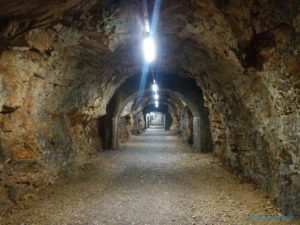





Spent 2 days in Siem Reap, Cambodia. Little town full of culture. Angkor Wat is an absolute gem on earth. Little cheeky tip: go on night out at Pub Street, then make your trip to go catch sunrise at Angkor Wat. Tell nobody 🙂
Hahaha – thank you, will follow your lead on my next visit – thank you!
Unfortunately, so many of these places are over saturated and highly unlikely to have the same impact anymore. It’s a shame to read about your experience, I’d like to visit Cambodia one day and see Angkor Wat. Maybe I’ll go when it’s the low season and avoid the posing Chinese tourists!
Hahaha – that’s exactly what I’m doing right now, albeit in Europe: Visiting places that are suffering from over-tourism when there is no pandemic. 😉
This brought back a few memories! I have to admit that I agree with you about Angkor Wat, it didn’t blow me away either & I also did the trek for sunrise which was underwhelming. My favourite temple was Ta Prohm, I just found the whole place magical & we also got there early & felt like we had it to ourselves. At Bayon, I felt we were ducking the attack of selfie-sticks all the time & didn’t really appreciate its beauty until afterwards when I saw the photos. This is a great guide & wish I’d had it before I went.
On our visit to SE Asia, we missed both Cambodia and Vietnam. Our son traveled in the region and certainly sent us lots of pics to show what we missed. We would definitely want to add Siem Reap to our travel plans. It would be good to visit the other temples than Angkor Wat and find a little less crowded spots. Even if Angor Wat looks like a fascinating spot to explore. Hiring a tuk tub to get around Siem Reap sounds like a great way to get around. I might want to do both the long and the short route. But would probably not pass on a sunset tour.
Cambodia is very high up on my list, especially because of Angkor Wat. Great to see what else there is to do around Siem Reap! Awesome guide.
This is a very exhaustive and informative post about the amazing temples of Siem Reap. Reading it brought back our memories of our own visit to Siem Reap a few years back. It is such an amazing place. Angkor Wat is, of course, magnificent, but there is so much more to Siem Reap. Some of our favourite temples other than Angkor Wat are Preah Khan and Bayon.
Siem Reap is certainly wonderful. I always realize how special a place is when I’m mesmerized…despite the large tourist crowds 😀